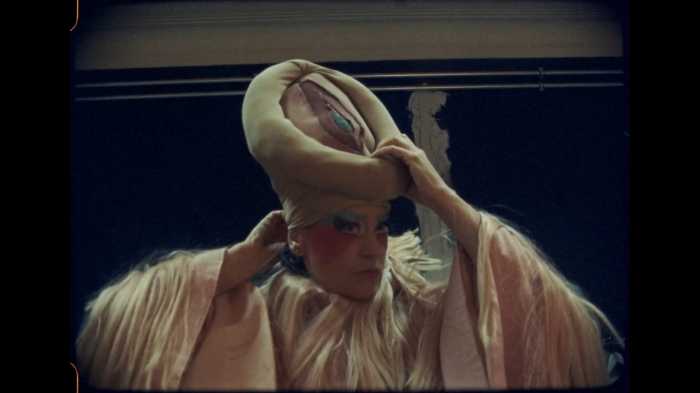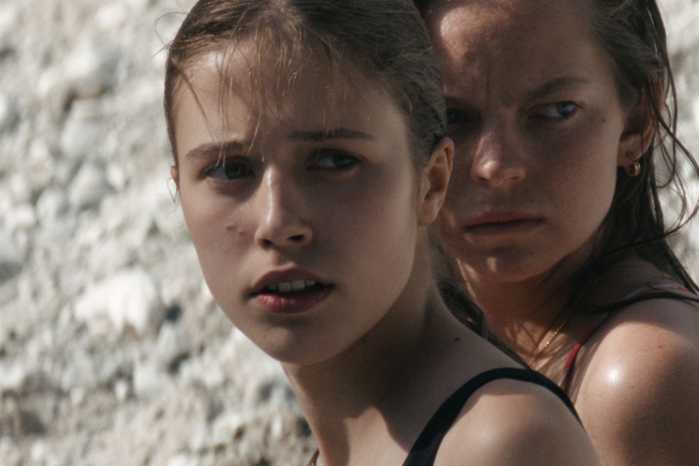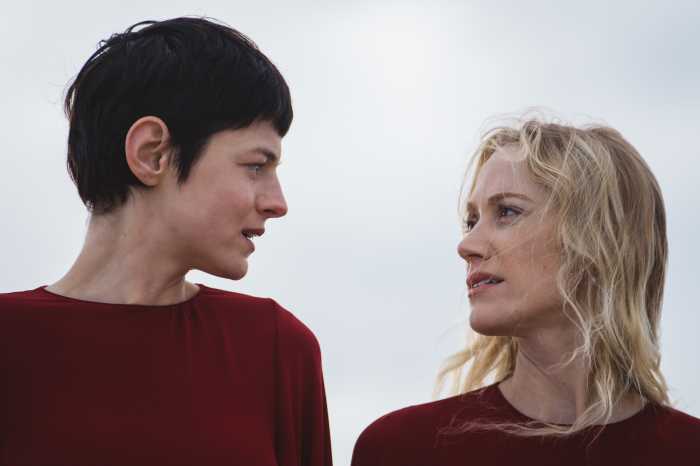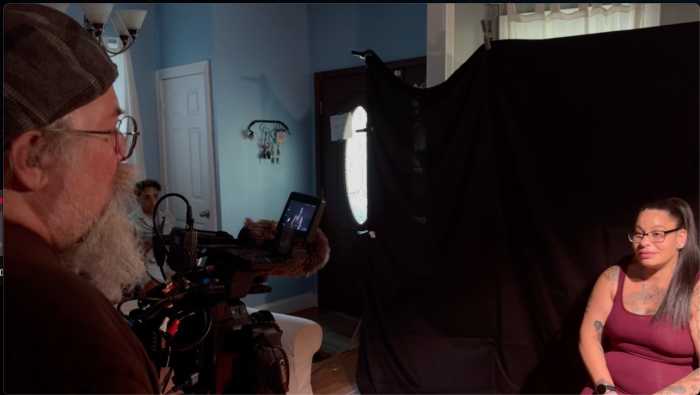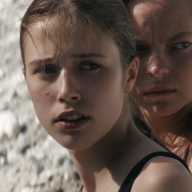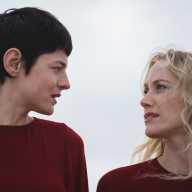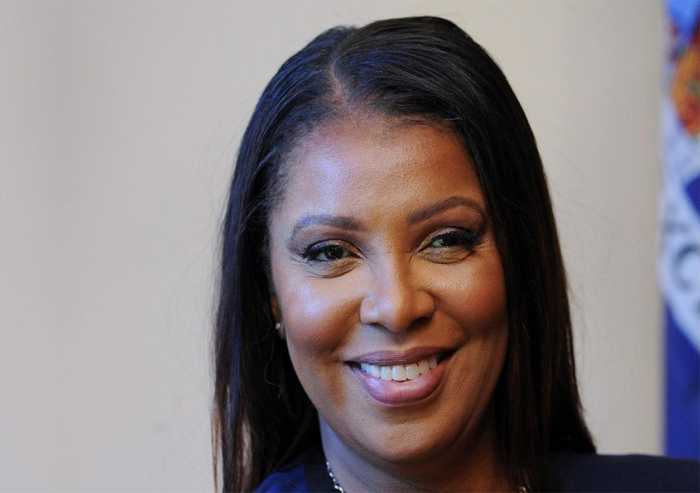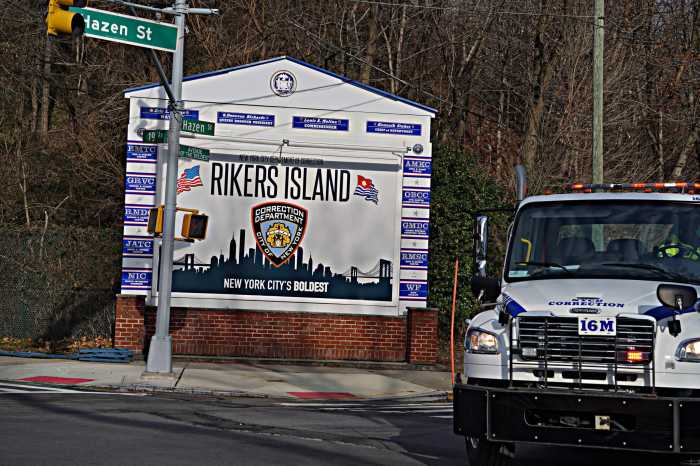Shot in upstate New York in a mere 12 days, India Donaldson’s feature debut, “Good One,” traces a camping trip undertaken by a queer teenager, Sam (Lily Collias), with her father Chris (James LeGros) and his friend Matt (Danny McCarthy). From the start, it’s tense and awkward. Sam takes care of the hike’s practical necessities, such as filling water bottles, and communicates with her girlfriend via text, while Chris and Matt lose themselves in endless talk. Their connection is frayed, with Matt revealing himself to be a bitter, deeply unhappy actor whose career is floundering. (He describes getting fired from a sales job under circumstances suggesting sexual misconduct.) Sam’s relative silence is striking, because Matt’s banter just digs himself further into a hole and reveals how fragile his friendship with Chris really is. While he forgot to pack his sleeping bag, he did remember to pack booze. The film builds tension through alternating talk and long, quiet passages. With one line, the jitters running through “Good One” finally reaching a snapping point, leading Sam to realize just how badly she can be betrayed by men. Donaldson shows a command of dynamics, using nature imagery to bring out a lonely beauty. It’s a striking coming-of-age drama that touches on a subtle alienation queer girls might feel from their parents. Gay City News spoke with Donaldson a week before the release of “Good One.”
The drama of “Good One” really pivots on one line and one scene. How long did you rehearse it, and how many takes did you do?
It was the last time we shot. We didn’t do any formal rehearsal, but the whole shoot was our preparation for it. The first part of us being able to execute that scene efficiently was that we did shoot it last, and that the actors and the whole crew had time to get to know each other and find the rhythm of the whole thing. We didn’t do any rehearsal, but the actors prepared so much. There’s a ton of dialogue, especially for those two guys. The scene takes a few different turns tonally. We actually shot it over two evenings, so we’d shoot other things in the daytime, then four or five hours in the evening as we were losing the light. The whole scene is 13 minutes cut together, but we never shot it beginning to end. We didn’t do more than three takes. The actors were really locked in. The lighting was the trickiest part, along with the color grading.
How do you think the dynamics between Sam, her father and Matt are affected by the fact that she’s queer?
It’s totally integral, and also just a fact of her life and identity. Regardless of her sexuality, things would play out the same way. There’s a scene early on where Matt says to her dad “You’re lucky she likes girls,” like a “men are gross” thing. He’s suggesting that her sexuality protects her from unwanted advances from men. I was trying to speak to some universal experience of girlhood and the dynamics that play out between father and child. There are so many aspects of her life that her father can’t connect with, and it’s one part of that: her openness, her ability to listen and communicate. Her dad can’t quite meet her on these things so that they understand each other.
When you approached male actors, did they tend to be receptive to the criticisms the film makes about their characters?
Absolutely. As actors, they’re interested in all of the shades of being human. I tried to approach writing these characters with empathy towards them. These guys weren’t judging their characters even when they behave badly. For me, that’s very important. They were drawn to the nuances of playing people who don’t always say or do the right thing.
With such a short shoot and the fact that it was all done outdoors, were there ever periods where nature took control of the production?
Every day there was a moment of that, sometimes for longer stretches. We’ve had to embrace rain and build it into the story. We lost almost a whole day of shooting to a thunderstorm where we just couldn’t go outside. We were a small team, and we made the most of time even as we were losing it. For example, during the thunderstorm, we set up tents on the porch of the Airbnb where we stayed and shot the actors inside them. We always tried to be capturing something instead of waiting around, because we didn’t have the luxury of adding days to the shoot. The cast and crew had to deal with constant tick checks. The natural world was very present in our experiences.
There’s a trope in horror movies where people who live in the city go out to the woods and find themselves in danger. “Good One” reminded me of “The Blair Witch Project,” although it’s not a horror film. Was that something you were thinking about?
I have such a vivid memory of seeing “The Blair Witch Project” at a movie theater when it came out. My younger brother introduced me to horror movies I wouldn’t otherwise have seen when I was very young, at eight or nine. “The Blair Witch Project” was such an immersive experience, where I was really drawn in by the characters and everything that plays out. I wasn’t specifically thinking of that film or the horror tropes, but culturally, they’re ingrained in me as a film lover. There’s a reason why the woods are scary. You lose control over so many things. It feels like you can see everything and nothing at all.
Did you intend a sense of menace from the characters’ isolation?
I was thinking about road trips into the wilderness and backpacking. Not being near amenities or having cell service, having to let to go of your comforts and access to information and communication, is inherently menacing for people who’ve lived most of their lives in the city. I was also thinking about a counter-intuitive claustrophobia. You’re going to the trail, but there’s no easy way out.
It’s unusual to see teenagers played by characters their own age. Was that part of casting Lily?
Definitely. I really wanted the actor to have proximity to that time in her life. We couldn’t afford to shoot with a minor, so we waited a year to work with her. She graduated high school, and then two weeks later, we were shooting. She was exactly at that point in her life. I was interested in what someone going through this transition in her own life would bring to that character, rather than casting an actor in her early 20s who could pass for a teenager.
The music has a strange quality, where parts sound like an interpretation of water running or chimes. There are also long passages of silence or just the sound of nature. Do you speak with composer Celia Hollander about integrating them?
Celia is a really avid backpacker and hiker herself. She composed the majority of the music while living in the area where we shot. That was a coincidence, but we thought about what the music would add conceptually. The texture of the natural world was foremost on her mind. I wanted there to be a conversation between music and sound design.
After making several shorts, how long did it take get production money for “Good One”?
It feels very long and short at the same time. For years, I’d been trying to make a different movie but couldn’t get the money together. Then COVID came, and it felt like “Oh my God, it’s so much harder to make an independent film.” All these challenges were added. I wrote this movie to be one I could make for a small amount of money. That’s how I approached my producers. I said, “Whatever the budget ends up being, I wanted to keep it small so I can make it and not have to wait years.” I put a lot of effort into that when I wrote it. We never had enough money. When we get into Sundance, we still didn’t. Every phase was a challenge.
Are you still trying to produce the bigger project?
One day I’d like to make it. We wrapped “Good One” at the end of June a year ago. I haven’t had a chance to think beyond it, but I hope I’m able to make another one. I’d like to revisit it.
As you’ve toured festivals with the film, have you heard from women who had similar relationships with their fathers?
Yes. It’s very gratifying to see it resonate with them. But it’s also meaningful to hear from fathers, men with adult children, say it clicked with them. That was unexpected.
It seems like a hard time to make indie films. For you, what would be the ideal of budget or studio involvement?
For me, every project has its own set of needs. I want to make it sustainable, so I can support myself and pay my collaborators. Everyone who came together to make this money deserves to be paid more. It’s hard, intense work. I’d like to make a film with more resources, so people can be paid sufficiently. But it’s nice to retain creative freedom and not have the pressure of massive budgets. I’d love to make another small film too. I found the intimacy of the process satisfying. I’m open to it all.


